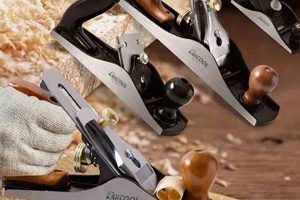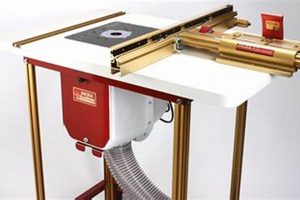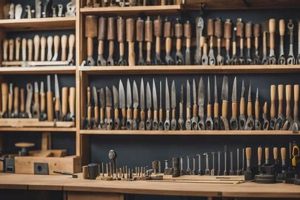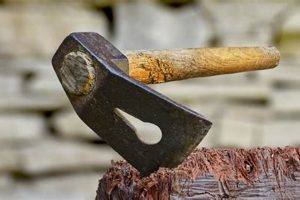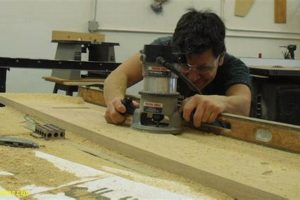The creation of implements for shaping wood using additive manufacturing processes allows for customized designs and rapid prototyping. These items range from simple jigs and fixtures to complex tool components, all produced through depositing material layer by layer based on a digital model. An example includes a custom-designed hand plane handle created to fit a specific user’s grip.
This method provides several advantages, including the ability to create tools tailored to specific tasks or ergonomic requirements. Historically, tool designs were limited by traditional manufacturing constraints; additive manufacturing overcomes these limitations, offering greater flexibility and customization. The practice supports efficient iterative design and reduces material waste, contributing to a potentially more sustainable approach to tool production.
The following sections will examine specific applications, material considerations, design principles, and future trends related to the implementation of additive manufacturing in crafting implements for the manipulation of wood.
Tips for Additive Manufacturing in Woodworking Implement Creation
Employing additive manufacturing for crafting woodworking implements requires adherence to specific guidelines to ensure durability, precision, and utility.
Tip 1: Material Selection is Paramount: Choose materials appropriate for the intended application. Consider factors such as strength, resistance to abrasion, and environmental stability. For example, a durable polymer like carbon fiber reinforced nylon is better suited for tools that will experience significant stress than a standard PLA.
Tip 2: Design for Printability: Account for the limitations of the additive manufacturing process during the design phase. Avoid overly complex geometries or unsupported overhangs that may require extensive support structures or lead to printing failures. Simplify designs where possible without sacrificing functionality.
Tip 3: Optimize Print Settings: Fine-tune printer settings such as layer height, infill density, and printing speed to maximize the strength and surface finish of the printed part. Experiment with different settings to find the optimal balance between print time and part quality.
Tip 4: Incorporate Reinforcements: For tools subjected to high stress or impact, consider incorporating internal reinforcement features into the design. This may include adding ribs, gussets, or embedding metal inserts to increase the tool’s structural integrity.
Tip 5: Post-Processing for Enhanced Durability: Utilize post-processing techniques such as sanding, coating, or applying sealants to improve the surface finish and durability of the printed tool. This can also help to protect the material from moisture and other environmental factors.
Tip 6: Test and Iterate: Thoroughly test printed tools in real-world woodworking scenarios to identify areas for improvement. Use the feedback gathered from testing to refine the design and manufacturing process through iterative prototyping.
Adhering to these recommendations can improve the effectiveness of additive manufacturing for creating high-quality woodworking implements and can reduce material waste.
The next segment will delve into specific case studies and examples of successful application of additive manufacturing techniques in the field of woodworking.
1. Customization potential
Additive manufacturing substantially enhances the customization of implements intended for woodworking. The layer-by-layer construction process allows for intricate geometries and features tailored to specific user needs or project requirements. This represents a departure from traditional manufacturing methods that often impose constraints on design complexity and personalization.
The ability to rapidly prototype and iterate designs significantly contributes to this customization potential. For example, a woodworker requiring a specialized marking gauge with a unique handle shape can design and produce it using additive manufacturing. This capability is particularly valuable for creating jigs and fixtures that conform precisely to specific workpieces, improving accuracy and efficiency. The customization potential extends to adapting tool dimensions to match the user’s hand size or grip preference, promoting ergonomic comfort and reducing fatigue.
Ultimately, the customization afforded by additive manufacturing allows for tools that are optimized for particular tasks and individual users. This, in turn, can lead to increased productivity, improved quality of workmanship, and reduced physical strain on the woodworker. The practical significance lies in providing woodworkers with the means to create tools that precisely meet their needs, empowering them to achieve greater precision and control in their craft.
2. Material Properties
Material properties are a foundational consideration in the additive manufacturing of woodworking implements. The selection of an appropriate material directly influences the tool’s strength, durability, resistance to wear, and overall performance in a woodworking context. Inadequate material selection can lead to premature failure, rendering the tool unusable and potentially hazardous. For example, using a brittle polymer for a mallet head would result in cracking or shattering upon impact, while a material lacking sufficient stiffness for a plane body could lead to inaccurate cuts.
The advent of diverse additive manufacturing materials, ranging from various plastics to composites, presents both opportunities and challenges. While polymers offer design flexibility and ease of printing, they often lack the rigidity and abrasion resistance of traditional tool materials like steel. Composite materials, incorporating fibers such as carbon or glass, can enhance strength and stiffness but require more complex printing processes. Practical applications necessitate a careful evaluation of the trade-offs between material cost, printability, and performance characteristics. A 3D-printed tenon jig, for instance, might benefit from a high-impact resistant polymer to withstand repeated clamping forces, while a delicate carving tool handle might prioritize ergonomic comfort over extreme durability.
In summation, material properties are inextricably linked to the viability of additively manufactured woodworking tools. A thorough understanding of these properties, combined with judicious material selection, is paramount to creating tools that are both functional and durable. Ongoing research into novel materials and printing techniques will continue to expand the possibilities for additive manufacturing in the woodworking field, while the importance of material selection remains crucial for achieving desired performance outcomes.
3. Design Complexity
Design complexity, as a component of additive manufacturing applied to woodworking implements, represents a significant paradigm shift. The capacity to generate intricate geometries and internal structures previously unattainable through conventional manufacturing processes introduces both opportunities and challenges. The direct effect of increased design freedom is the ability to optimize tools for specific tasks and ergonomic considerations. For instance, a complex internal lattice structure within a 3D-printed hand plane body can provide superior strength-to-weight ratio compared to a solid, machined counterpart. The practical significance of this capability lies in the potential for creating tools that are lighter, more durable, and more precisely tailored to the individual user.
However, design complexity introduces considerations related to printability and material properties. Overly complex designs may require extensive support structures during printing, increasing material usage and post-processing time. The chosen material must also be capable of accurately reproducing the designed geometry without compromising structural integrity. A real-life example would be the creation of a custom-fit router base with integrated dust collection ports. The intricate design of the dust collection system, optimized for airflow efficiency, could only be realized through additive manufacturing. However, the success of this application hinges on selecting a material with sufficient stiffness to maintain dimensional accuracy during use.
In summary, design complexity is a defining characteristic of 3D-printed woodworking implements, enabling innovative tool designs and customized solutions. However, realizing the full potential of this capability requires a thorough understanding of additive manufacturing processes, material limitations, and the trade-offs between design intricacy, printability, and performance. Future advancements in materials and printing technologies will likely further expand the possibilities for design complexity, driving innovation in the field of woodworking tool design.
4. Ergonomic considerations
The intersection of ergonomic considerations and additive manufacturing in woodworking tool design provides opportunities to mitigate physical strain and improve user comfort. The ability to tailor tool dimensions, grip profiles, and weight distribution through additive manufacturing allows for the creation of tools specifically suited to an individual’s hand size, grip strength, and working style. This level of customization directly addresses the limitations of mass-produced tools, which often fail to accommodate the diverse physical characteristics of woodworkers. The impact of ergonomic design on tool usage is evident in reduced hand fatigue, minimized risk of repetitive strain injuries, and enhanced overall work efficiency. A practical example is the creation of a custom-molded handle for a carving knife, precisely contoured to the user’s hand to minimize stress on tendons and joints. This enhanced grip promotes greater control and precision, improving the quality of the carving work.
Further application of ergonomic principles involves the optimization of tool weight and balance. Additive manufacturing enables the strategic distribution of material within a tool to achieve optimal balance, reducing the effort required to maintain control and minimizing strain on muscles. For instance, a 3D-printed hand plane body can be designed with internal voids to reduce overall weight while maintaining structural integrity. The impact of these refinements is tangible, resulting in a tool that feels more natural and comfortable to use, particularly during prolonged periods of work. The practical consequences encompass enhanced job satisfaction, improved work quality, and decreased likelihood of work-related musculoskeletal disorders.
In summary, ergonomic considerations are fundamental to the successful application of additive manufacturing in woodworking tool creation. The capacity to customize tool design to individual user needs provides a path towards safer, more comfortable, and more efficient woodworking practices. The challenges lie in accurate assessment of ergonomic requirements and the judicious application of additive manufacturing techniques to translate these requirements into functional tool designs. This comprehensive approach ensures that the resulting tools not only perform their intended tasks effectively but also contribute to the long-term well-being of the woodworker.
5. Prototyping speed
Additive manufacturing significantly accelerates the iterative design process for woodworking implements. This rapid prototyping capability enables designers and woodworkers to quickly translate concepts into tangible objects, test their functionality, and refine designs based on empirical feedback, thereby reducing the time and cost associated with traditional prototyping methods.
- Accelerated Design Iteration
Additive manufacturing facilitates rapid design iteration by allowing for the creation of physical prototypes within hours or days, rather than weeks or months as required by conventional machining techniques. This accelerated timeline enables designers to explore a wider range of design options, identify potential flaws early in the development process, and implement necessary changes quickly. An example is the rapid development of multiple iterations of a custom chisel handle, each with subtle variations in grip geometry, to optimize ergonomics based on user feedback.
- Reduced Manufacturing Lead Times
The additive manufacturing process eliminates the need for complex tooling and setup procedures, significantly reducing manufacturing lead times for woodworking implement prototypes. This reduction in lead time allows for quicker validation of design concepts and faster time-to-market for new tools or modifications to existing tools. A practical demonstration of this is the swift production of a bespoke router jig, tailored to a specific woodworking project, eliminating the delays associated with outsourcing the jig’s fabrication.
- Cost-Effective Design Exploration
By enabling the rapid and inexpensive creation of prototypes, additive manufacturing reduces the financial risk associated with design exploration. Designers can experiment with unconventional designs and materials without incurring significant costs, fostering innovation and leading to the development of more effective and ergonomic woodworking tools. Consider the development of a novel hand plane design incorporating complex internal structures to minimize weight while maintaining structural integrity; additive manufacturing permits the creation of multiple prototypes with varying internal geometries to identify the optimal design configuration without excessive financial burden.
In summation, the increased prototyping speed afforded by additive manufacturing empowers woodworkers and tool designers to innovate more rapidly, refine designs based on real-world testing, and bring new and improved woodworking implements to market more efficiently. This capability has a direct impact on the quality, functionality, and user-friendliness of additively manufactured woodworking tools, enhancing their overall value and practicality in the woodworking profession.
6. Cost effectiveness
The application of additive manufacturing techniques to the production of woodworking implements presents a complex equation regarding cost effectiveness. While certain aspects indicate potential cost savings, other factors contribute to expenses that must be carefully considered.
- Reduced Material Waste
Additive manufacturing minimizes material waste by depositing material only where needed, unlike subtractive methods that remove material to create a shape. In woodworking tool creation, this can significantly reduce the overall material consumption, especially when using expensive or specialized materials. For example, creating a custom handle for a spokeshave using traditional methods might require removing a substantial amount of material from a larger block, resulting in significant waste. Additive manufacturing can produce the same handle with minimal waste, potentially lowering material costs.
- Lower Tooling Costs
Additive manufacturing eliminates the need for expensive tooling and molds that are typically required in traditional manufacturing processes. This can be particularly advantageous for producing small batches of specialized woodworking tools or custom jigs, where the tooling costs associated with traditional methods would be prohibitive. For instance, producing a single, highly specialized dovetail jig using conventional machining would involve significant setup costs, whereas additive manufacturing allows for direct production from a digital model without additional tooling expenses.
- Potential for On-Demand Production
Additive manufacturing enables on-demand production of woodworking tools, reducing the need for maintaining large inventories. This can significantly lower storage costs and eliminate the risk of obsolescence for specialized tools that are not frequently used. A practical example includes printing replacement parts for vintage woodworking machines as needed, rather than attempting to source rare or discontinued components, thereby reducing downtime and maintenance expenses.
- Initial Investment and Operating Costs
Despite the potential for savings, additive manufacturing necessitates an initial investment in 3D printing equipment and materials. Furthermore, operating costs, including electricity, maintenance, and the cost of specialized software, must be factored into the equation. For small-scale operations or hobbyist woodworkers, the initial investment might outweigh the long-term cost savings, especially when compared to purchasing readily available, mass-produced woodworking tools. Conversely, for professional woodworkers or businesses involved in custom tool design, the long-term benefits of reduced material waste, lower tooling costs, and on-demand production may justify the initial investment.
The overall cost effectiveness of additive manufacturing for woodworking implements depends on a variety of factors, including the scale of production, the complexity of the designs, the cost of materials, and the availability of skilled personnel to operate and maintain the equipment. A thorough cost-benefit analysis is essential before adopting this technology to ensure that it aligns with specific needs and financial constraints.
7. Tool durability
The capacity of woodworking implements fabricated via additive manufacturing to withstand prolonged use and resist degradation under operational stress constitutes a critical determinant of their practicality and economic viability. Tool durability directly influences longevity, performance consistency, and safety during woodworking activities.
- Material Selection and Mechanical Properties
The selection of materials for additive manufacturing significantly impacts tool durability. Polymers, composites, and, less commonly, metals, each exhibit distinct mechanical properties concerning tensile strength, impact resistance, and resistance to abrasion. For instance, a tool fabricated from a high-performance polymer like carbon fiber reinforced nylon demonstrates greater durability than one composed of standard PLA. The material’s ability to withstand repetitive stress and resist wear directly affects the tool’s lifespan and performance consistency.
- Print Orientation and Layer Adhesion
Print orientation during the additive manufacturing process influences layer adhesion and overall structural integrity. Orienting a part to minimize stress on layer lines can enhance its resistance to fracture. Inadequate layer adhesion, resulting from improper print settings or material incompatibility, weakens the tool and reduces its durability. A tool designed with optimized print orientation withstands operational forces more effectively, extending its usable life.
- Post-Processing Techniques and Surface Treatment
The application of post-processing techniques, such as surface coating or heat treatment, can enhance the durability of additively manufactured woodworking tools. Surface coatings provide a protective barrier against moisture, chemicals, and abrasion, while heat treatment can improve material hardness and resistance to deformation. For example, applying a polyurethane coating to a 3D-printed mallet head protects it from splintering and cracking, extending its functional lifespan.
- Design for Durability and Stress Distribution
Tool designs incorporating features that promote even stress distribution and minimize stress concentrations enhance durability. Reinforcing ribs, rounded corners, and optimized geometries reduce the likelihood of failure under load. A well-designed 3D-printed hand plane, for instance, incorporates internal bracing to distribute cutting forces evenly across the body, preventing localized stress concentrations that could lead to cracking or deformation.
The collective influence of material selection, print parameters, post-processing techniques, and design considerations defines the overall durability of woodworking tools created through additive manufacturing. A comprehensive understanding of these factors is essential to produce implements that withstand the rigors of woodworking tasks and provide long-term value to the user. Continuous advancements in materials science and additive manufacturing technologies are expected to further enhance the durability of these tools, expanding their applications within the woodworking domain.
Frequently Asked Questions
The following section addresses common inquiries concerning the application of additive manufacturing to the creation of woodworking tools. The intent is to provide clarity on prevalent misconceptions and offer practical insights.
Question 1: What level of precision can be achieved with additively manufactured woodworking tools?
The achievable precision is contingent upon the printing technology, materials, and post-processing methods employed. Certain additive manufacturing processes can produce parts with tolerances comparable to those achieved through traditional machining, suitable for many woodworking applications. However, critical dimensions may require post-printing refinement for optimal accuracy.
Question 2: Are additively manufactured woodworking tools as strong and durable as traditional metal tools?
The strength and durability depend on the material selection and design. While some polymers may not match the strength of steel, composite materials and advanced polymers can provide adequate strength for specific applications. Optimized designs, incorporating features like reinforcing ribs and stress distribution, can further enhance durability. Not all additively manufactured implements equal the robustness of their metal counterparts.
Question 3: What types of woodworking tools are most suitable for additive manufacturing?
Jigs, fixtures, measuring tools, and tool handles are often well-suited for additive manufacturing due to their complex geometries and customization requirements. Cutting tools, which require high hardness and wear resistance, present a greater challenge and may necessitate hybrid manufacturing approaches combining additive and subtractive techniques.
Question 4: What are the primary limitations of using additive manufacturing for woodworking tools?
Limitations include material constraints, print size limitations, and potential for anisotropic material properties. The range of materials suitable for woodworking tools is more limited than that available for traditional manufacturing. The size of the 3D printer restricts the size of the tool that can be produced in a single piece. Anisotropic properties, where material strength varies with direction, require careful consideration during design and print orientation.
Question 5: How does the cost of additively manufactured woodworking tools compare to traditionally manufactured tools?
The cost comparison varies depending on factors such as production volume, design complexity, and material costs. For small-batch production of custom tools, additive manufacturing can be more cost-effective than traditional methods due to the elimination of tooling costs. However, for mass production of standard tools, traditional manufacturing processes typically offer a lower per-unit cost.
Question 6: What future developments can be expected in additive manufacturing for woodworking tools?
Future advancements are expected in the development of new materials with improved strength and durability, increased printer build volumes, and improved printing resolution. Hybrid manufacturing approaches, combining additive and subtractive techniques, will likely become more prevalent, enabling the creation of tools with both complex geometries and high-precision cutting edges.
Additive manufacturing provides opportunities and constraints in the realm of woodworking implement creation. A measured assessment of material properties, design considerations, and cost factors is paramount before implementation.
The following section will address potential environmental considerations when using this technique.
Conclusion
This exploration of implements for shaping wood manufactured via additive processes has highlighted the technology’s multifaceted potential and inherent limitations. The discussion has encompassed customization capabilities, material property considerations, design complexities, ergonomic enhancements, prototyping speeds, cost implications, and the crucial element of tool durability. These facets collectively influence the viability and efficacy of employing additive manufacturing within the woodworking domain.
The successful integration of 3d print woodworking tools into contemporary practice necessitates a rigorous understanding of material science, design optimization, and manufacturing process control. Further research into novel materials and refined printing techniques will undoubtedly expand the application landscape. However, careful evaluation and judicious implementation remain paramount to realizing the full benefits and mitigating the associated risks. The future trajectory hinges upon continuous innovation and a commitment to evidence-based practices.



